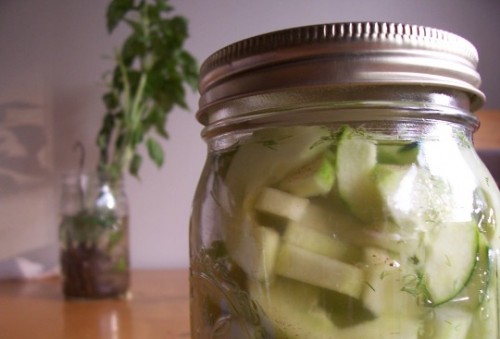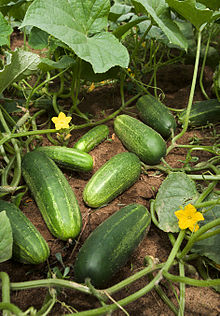Friday 25 October 2013
Tuesday 22 October 2013
Cucumbers
| Cucumbers grow on vines, I just love them and seem to find them delicious in almost any dish. They are excellent in salads, soups, green juices and smoothies. I also make a dressing which is very nice; Use lemon, garlic, mint, oil, avocado, salt & pepper & pour over some sliced cucumbers....wonderful for lunch on a hot day, alkalising, rehydrating & refreshing ! |

I didn't know all the benefits of cucumbers until I read this list below, but perhaps my body does, as I love to grab a cucumber as a snack sometimes!
1) Cucumber rehydrates body
If you are too busy to drink enough water, eat the cool cucumber, which is 98 percent water. It will cheerfully compensate your water lost.
2) Cucumber fights heat inside and out
Eating cucumber will get your body relief from heartburn. Apply cucumber on your skin and you will get relief from sunburn.
3) Cucumber eliminates toxins
All that water in cucumber acts as a virtual broom, sweeping waste products out of your body. With regular eating, cucumber is known to dissolve kidney stones.
4) Cucumber replenishes daily vitamins
Cucumbers have most of the vitamins the body needs in a single day. A B and C, which supports your immune system keep you radiant and give you energy. Make it more powerful by juicing cucumber with spinach and kale. Don't forget to leave the skin on because it contains a good amount of vitamin C, about 12 percent of the daily recommended allowance.
5) Cucumber supplies skin friendly minerals
Cucumber is high in potassium, magnesium and silicon. That is why spas abound cucumber based treatments.
7) Cucumber revives the eyes
Placing a chilled slice of cucumber over puffy eyes is a clichéd beauty visual but it really can help reduce under-eye bags and puffiness due to its anti inflammatory properties.
8) Cucumber cures diabetes, reduces cholesterol and controls blood pressure
Cucumber juice contains a hormone which is needed by the cells of the pancreas for producing insulin which is widely spread to be beneficial to diabetic patients. Researchers have found that a compound called sterols in cucumbers can help decrease levels of cholesterol. Cucumbers contain a lot of fiber, potassium and magnesium. These nutrients work effectively for regulating blood pressure. That is why cucumber is good for treating both high blood pressure and low blood pressure.
9) Cucumber refreshes the mouth
Cucumber juice heals and refreshes diseased gums. Get a slice of cucumber and press it to the roof of your mouth with your tongue for a half minute, the phytochemcials will kill the bacteria in your mouth responsible for causing unpleasant breath.
10) Cucumber smooths hair and nails
The wonder mineral Silica in cucumber makes your hair and nails shinier and stronger. The sulfur and silica in cucumbers help to stimulate your hair growth.
11) Cucumber promotes joint health, relieves arthritis and gout pain
As cucumber is an excellent source of silica it promotes joint health by strengthening the connective tissues. When mixed with carrot juice, cucumber can relieve gout and arthritis pain by lowering levels of the uric acid.
12) Cucumber keeps kidneys in shape
Cucumber lowers uric acid levels in your body and though keeping the kidneys healthy.
13) Cucumber is the number 1 alkalizing fruit
Cucumber is high in potassium, magnesium and silicon which are alkalizing minerals making them number 1 in alkalizing the alimentary canal, blood and tissues.
Eating a cucumber a day will keep the Doctor away!
Tuesday 8 October 2013
How to Harvest Kale
- Kale has become a very popular and easy plant to grow and the dark green leaves are super healthy!
- It goes on and on in the garden with months of eating, but I thought you might like to know how to care for the plant when harvesting the leaves so it just keeps on producing. The white butterfly loves them so I have a finely wired cage where I grow mine along with my cauliflowers and cabbages, so I don't require any sprays and the leaves don't get chewed by caterpillars ! It works perfectly.
- I love to put 3 or 4 leaves in my smoothie or juice but it also makes a great salad; finely chop or just tear into pieces the leaves, massage in some lemon juice, salt and olive oil & Voila..it's ready and a great accompaniment to any meal ! I sometimes add some nuts, cranberries or sultanas and pomegranate seeds ( they are delish!) but you can add anything really if you so desire, to make it more interesting.
- My real favourite are kale chips; I made a whole batch this week & are they yum oh! Just break or tear the leaves into fairly big pieces & coat with a sauce of your choice.The sauce I poured over was a blend of cashews, sundried tomatoes, lemon juice & zest, maple syrup and a red capsicum, onion & garlic powder, salt all mixed in the food processor to taste; I sometimes add some nutritional yeast which gives it a cheesy flavour. Dehydrate or put in a very very low heat in the oven for a couple of hours on a tray, turn til dry; they won't take long so don't leave them overnight as an example, or they will be ash in the morning !
 “MORE KALE PLEASE”
“MORE KALE PLEASE” Here’s Dinosaur Kale – aka Lacinato Kale, and it’s ready for the first picking. It has around 12 mature leaves, and five immature leaves which we won’t pick until the next harvest.
First, hold the plant steady and grab the bottom leaf and push down, like in the picture, until the joint between stalk and stem snaps a bit.
Next, bend the stem to the right, until it snaps again. You’ll feel it, and probably hear it too. Just bend it, don’t tear – you’ll be able to take it off at this step when you get really good, but not yet – unless you want to hurt the plant.
Now bend the leaf to the left, and it should snap again, this time maybe completely off.
You’re trying to separate the leaf from the stalk, right at the joint, without hurting the plant; so you can get around 100+ more leaves off it.
The last step, if the leaf is even still connected, is to bend up, which should break any remaining connection the stem has to the plant. You should see a nice clean break. If all else fails, just cut the stem close to the stalk with scissors.
Then you move on to the next lowest leaf, and then the next one up, and so on, all the way to the top…
Don’t pick the topmost leaves, because they’re the little “solar panels” that are going to drive the plant to grow more leaves for you to harvest… and the cycle continues.
This plant got picked a bit too far, but it’ll live. It still has leaves that’ll grow to maturity and the main bud is still there, so new leaves are being made every second, and you can keep picking for months.
Now you just need to do something with it all. Start with something like a simple kale salad.
Subscribe to:
Posts (Atom)








